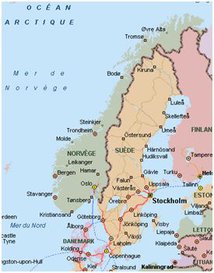Border: Norway-Sweden
Date(s) of establishment: Current demarcation in 1660Length of border: 1630 km
Regions concerned: Sweden – Norrbotten, Västerbotten, Jämtland, Dalarna, Värmland, Västra Götaland; Norway – Troms, Nordland, Nord-Trøndelag, Sør-Trøndelag, Hedmark, Akershus, Østfold
European programme(s):
- Interreg IV A "Sweden-Norway":
Website of the programme
The programme on the Inforegio website - Interreg IV A "North":
Website of the programme
The programme on the Inforegio website - Interreg IV A "Botnia-Atlantica":
Website of the programme
The programme on the Inforegio website - Interreg IV A "Öresund - Kattegatt - Skagerrak":
The programme on the Inforegio website
At a length of 1630 km, the boundary line between Sweden and Norway in most part follows the demarcation of waters in the Scandinavian Alps. It begins in the north at the "Treriksroset" tripoint, situated on the banks of the lake Goldajarvi, where a monument marks the crossing of the Swedish-Norwegian and Finnish-Norwegian borders. In the south the border comes to an end near the village of Sponvika in the municipality of Halden.
History
The border has undergone several modifications, notably as a result of armed conflicts. In 1645 the kingdom of Denmark-Norway ceded several provinces to Sweden under the terms of the Treaty of Bromsebro, subsequently also ceding the provinces of Trondelag and Bohuslan to Sweden in 1658. In 1660, the Treaty of Copenhagen confirmed the terms of the preceding treaties but required Sweden to return Trondelag.
In 1905, upon the dissolution of the union between Norway and Sweden, Norway was forced to demolish several of its fortresses constructed along the border.
During the Second World War, many Norwegians left their country, then occupied by Germany, in order to settle in Sweden, a neutral country.
Having undergone few changes since the creation of the two states, this is therefore a well established border.
Cross-border cooperation
Very unbalanced, this vast cross-border region is characterised by large disparities. Certain areas are very dynamic but as a whole, population growth is negative and the level of education is lower than the national average.
- In this context, the “Sweden-Norway” Interreg programme aims to improve economic growth in the region, and reduce the inequalities within the territory. To reach this goal, cooperation largely depends on the creation of an integrated job market adapted to the cross-border space. This would also allow businesses to collaborate in the long term and attract a qualified workforce. Improvement of living standards is another goal of cooperation, to boost the momentum in the cross-border area. This requires improvement in the efficiency of public services and urban development methods. Bolstering collaboration in the fields of public health and risk prevention is also among the priorities for the improvement of inhabitants’ safety and wellbeing.
- There are additional Interreg programmes that cover the two countries, but not exclusively. One of these is the “North” Interreg programme, in which Finland also participates. It duplicates all the objectives of the previously cited programme, while also emphasising the need to bolster cohesion in the Scandinavian region through the development of cross-border relations.
- The "Oresund–Kattegatt–Skagerrak" operational programme has also contributed to stronger cooperation links between the two countries. The programme aims to turn the "Oresund–Kattegatt–Skagerrak" region into one of the most competitive and attractive in Europe. In order to achieve this, its objectives concern the economy, as well as identity: strengthening regional links and encouraging integration in the daily lives of inhabitants with the establishment of different partnerships.
- The first programme aside, the latter two do not cover the northern portions of the two countries. These areas are covered by the "Botnia-Atlantica" programme, which aims to improve cooperation structures, particularly in the fields of communication and culture.
Two large Euroregions partially cover this cross-border territory: the "Mittnorden Committee" and the "North Calotte Council". Their numerous cross-border initiatives, such as the “Nordic Culture Days” and the “Energy and Environment Prize”, aim to give this territory its own identity and a new lease of life.


